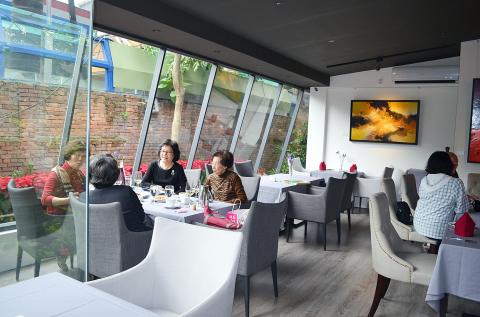In a city with a rich, diverse past like Taipei, serendipity comes in many ways. Tom Chen (陳登壽) owns Jimmy’s Kitchen, a famous Shanghai restaurant with its own history — one that included the original owner fleeing to Taiwan from Shanghai in 1949. But Chen always had another dream.
Chen began work in the service industry at the Grand Hotel, which sent him to Lubeck, Germany to learn bar tending. While there, he became fascinated with the vibrant, raucous atmosphere of salons — places where artists, writers and academics would meet and discuss art and other topics. Chen’s dream was to bring that experience back to Taiwan.
Enter Wolfgang Kroll (1906-1992), a Professor Emeritus in Physics at National Taiwan University (NTU) who grew up in Germany at the height of the Art Deco period. Kroll held the belief that art, literature and science should interrelate.

Photo: Jerome Keating
Kroll may not be a household name with most Taipei residents, but he is well known in the medical and science community because he helped draw international attention to the university, and was responsible for teaching theoretical physics as well as German to generations of physicists and future doctors even after his official retirement.
Kroll, who studied quantum mechanics in Germany under Nobel Prize-winning physicist Werner Heisenberg, emigrated from his home country after Hitler and the Nazi party came to power because one grandparent had Jewish ancestry. With a fascination for Japanese language and culture, Kroll went to Japan in 1937, and then, in 1941, its then-colony Taiwan. One of Kroll’s research papers became the first paper from Taiwan to be published in an international journal.
Until his death in 1992, Kroll lived for half a century in a small Japanese-style house belonging to the university. After his death, the building returned to NTU, which offered it up for development. Still nurturing the dream of a salon, Chen, along with his artist and interior designer-friend Tsai Wen-hsiung (蔡文雄), signed a seven-year lease with the university with an option for renewal. Six months later, the split-level, upscale salon with plenty of natural lighting and artwork, opened to the public as Jimmy’s Garden.
Not strictly a gallery, though art is everywhere, or a restaurant, though you can go there for a meal as well as teatime, Jimmy’s Garden tries to replicate the ambiance of a salon, where he hopes that a new generation of artists, academics and intellectuals will come together over a glass of wine or cup of coffee to discuss and debate current events.
Artists are encouraged to submit an application to display their work at Jimmy’s Garden. Yu Lien-chun’s (余連春) terracotta and metal sculptures are on display until Jan. 31. The salon is open daily from 11am to 9pm and closed on Mondays. 5, Ln 11, Xinsheng S Rd, Sec 3, Taipei City (台北市新生南路三段11巷5號); tel: (02) 2368-1197.

Taiwan doesn’t have a lot of railways, but its network has plenty of history. The government-owned entity that last year became the Taiwan Railway Corp (TRC) has been operating trains since 1891. During the 1895-1945 period of Japanese rule, the colonial government made huge investments in rail infrastructure. The northern port city of Keelung was connected to Kaohsiung in the south. New lines appeared in Pingtung, Yilan and the Hualien-Taitung region. Railway enthusiasts exploring Taiwan will find plenty to amuse themselves. Taipei will soon gain its second rail-themed museum. Elsewhere there’s a number of endearing branch lines and rolling-stock collections, some

Could Taiwan’s democracy be at risk? There is a lot of apocalyptic commentary right now suggesting that this is the case, but it is always a conspiracy by the other guys — our side is firmly on the side of protecting democracy and always has been, unlike them! The situation is nowhere near that bleak — yet. The concern is that the power struggle between the opposition Chinese Nationalist Party (KMT) and their now effectively pan-blue allies the Taiwan People’s Party (TPP) and the ruling Democratic Progressive Party (DPP) intensifies to the point where democratic functions start to break down. Both

The Democratic Progressive Party (DPP), Chinese Nationalist Party (KMT), and the country’s other political groups dare not offend religious groups, says Chen Lih-ming (陳立民), founder of the Taiwan Anti-Religion Alliance (台灣反宗教者聯盟). “It’s the same in other democracies, of course, but because political struggles in Taiwan are extraordinarily fierce, you’ll see candidates visiting several temples each day ahead of elections. That adds impetus to religion here,” says the retired college lecturer. In Japan’s most recent election, the Liberal Democratic Party lost many votes because of its ties to the Unification Church (“the Moonies”). Chen contrasts the progress made by anti-religion movements in

This was not supposed to be an election year. The local media is billing it as the “2025 great recall era” (2025大罷免時代) or the “2025 great recall wave” (2025大罷免潮), with many now just shortening it to “great recall.” As of this writing the number of campaigns that have submitted the requisite one percent of eligible voters signatures in legislative districts is 51 — 35 targeting Chinese Nationalist Party (KMT) caucus lawmakers and 16 targeting Democratic Progressive Party (DPP) lawmakers. The pan-green side has more as they started earlier. Many recall campaigns are billing themselves as “Winter Bluebirds” after the “Bluebird Action”